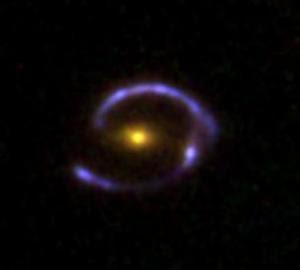
Astronomers at the California Institute of Technology (Caltech) and their colleagues have provided unique insight into the nature of a young star-forming galaxy as it appeared only two billion years after the Big Bang and determined how the galaxy may eventually evolve to become a system like our own Milky Way.
The team made their observations by coupling two techniques, gravitational lensing--which makes use of an effect first predicted by Albert Einstein in which the gravitational field of massive objects, such as foreground galaxies, bends light rays from objects located a distance behind, thus magnifying the appearance of distant sources.
Using the Hubble Space Telescope, the team located a distinctive galaxy dubbed the "Cosmic Eye" because its form is distorted into a ring-shaped structure by the gravitational field of a foreground galaxy.
"Gravity has effectively provided us with an additional zoom lens, enabling us to study this distant galaxy on scales approaching only a few hundred light-years. This is 10 times finer sampling than hitherto possible", explains postdoctoral research scholar Dan Stark of Caltech, the leader of the study. "As a result, we can see, for the first time, that a typical-sized young galaxy is spinning and slowly evolving into a spiral galaxy much like our own Milky Way", he says.
To know more got to Science Daily
Nature paper
No hay comentarios:
Publicar un comentario